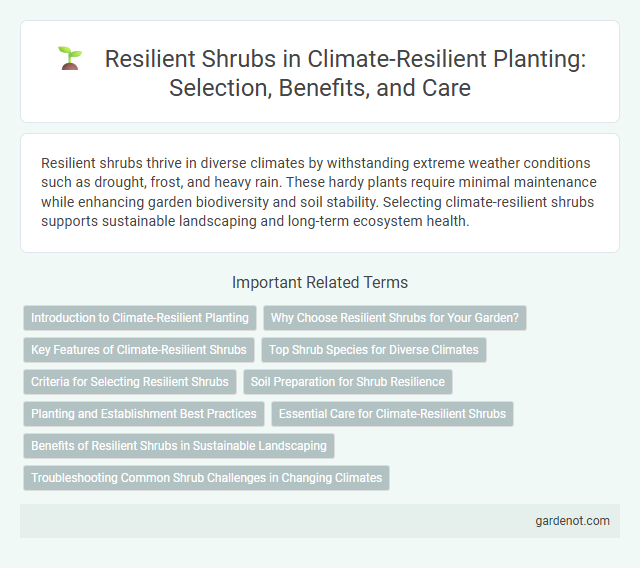Resilient shrubs thrive in diverse climates by withstanding extreme weather conditions such as drought, frost, and heavy rain. These hardy plants require minimal maintenance while enhancing garden biodiversity and soil stability. Selecting climate-resilient shrubs supports sustainable landscaping and long-term ecosystem health.
Introduction to Climate-Resilient Planting
Resilient shrubs play a crucial role in climate-resilient planting by withstanding extreme weather conditions such as drought, heat, and flooding. Species like lavender, juniper, and manzanita possess deep root systems and adaptable growth patterns, making them ideal for sustainable landscaping in changing climates. Incorporating these shrubs helps stabilize soil, conserve water, and support biodiversity, thereby enhancing ecosystem resilience and reducing maintenance needs.
Why Choose Resilient Shrubs for Your Garden?
Resilient shrubs enhance garden sustainability by withstanding extreme weather conditions, drought, and varying soil types, reducing water use and maintenance needs. These hardy plants improve biodiversity, providing habitat and food for pollinators and wildlife, while promoting soil health through deep root systems. Choosing resilient shrubs supports long-term landscape stability and climate adaptation, ensuring vibrant gardens in changing environments.
Key Features of Climate-Resilient Shrubs
Climate-resilient shrubs possess deep root systems that enhance water absorption and retention during drought conditions, supporting sustained growth in arid environments. Their waxy, thick leaves reduce transpiration and shield against extreme temperature fluctuations, ensuring durability through heatwaves and sudden frosts. These shrubs also exhibit rapid regeneration capabilities, allowing recovery from physical stressors such as storms or pest infestations, making them ideal for climate-adaptive landscaping.
Top Shrub Species for Diverse Climates
Top shrub species for diverse climates include drought-tolerant plants like lavender, rosemary, and manzanita, known for their ability to thrive in arid conditions and resist heat stress. Native shrubs such as ceanothus and sagebrush offer exceptional resilience in Mediterranean and semi-arid regions due to their deep root systems and adaptability. These resilient shrubs improve soil stability, support local biodiversity, and reduce water usage, making them ideal choices for climate-resilient planting strategies.
Criteria for Selecting Resilient Shrubs
Resilient shrubs for climate-resilient planting are selected based on their drought tolerance, ability to withstand temperature extremes, and resistance to pests and diseases. Soil adaptability and low water requirements ensure these shrubs thrive in changing environmental conditions. Selecting native species enhances ecosystem stability and supports local biodiversity.
Soil Preparation for Shrub Resilience
Proper soil preparation enhances shrub resilience by improving aeration, drainage, and nutrient availability essential for climate stress tolerance. Incorporating organic matter like compost increases moisture retention and supports beneficial microbial activity critical for shrub root health. Testing soil pH and amending with lime or sulfur ensures optimal nutrient uptake, promoting robust growth under variable climatic conditions.
Planting and Establishment Best Practices
Selecting drought-tolerant shrub species such as Ceanothus or Artemisia enhances climate resilience by minimizing water dependency during establishment. Optimal planting techniques include deep watering at planting time combined with mulching to retain soil moisture and regulate temperature. Early-stage monitoring for pest stress and soil compaction supports healthy root development and long-term shrub survival in variable climates.
Essential Care for Climate-Resilient Shrubs
Climate-resilient shrubs require well-drained soil, adequate mulching, and consistent watering during dry spells to establish strong root systems. Pruning should be minimal and timed to avoid stress during extreme weather conditions, promoting healthy growth and resistance to climate fluctuations. Monitoring for pests and diseases is essential to maintain shrub vitality and ensure long-term resilience in changing environments.
Benefits of Resilient Shrubs in Sustainable Landscaping
Resilient shrubs enhance sustainable landscaping by improving soil stability and reducing erosion through their extensive root systems, which promote water retention and nutrient cycling. They also provide critical habitats for pollinators and native wildlife, supporting biodiversity in urban and rural green spaces. Their drought-tolerant traits lower irrigation demands, making landscapes more resilient to climate change and reducing water resource strain.
Troubleshooting Common Shrub Challenges in Changing Climates
Drought-tolerant shrubs such as manzanita and ceanothus thrive in climate-resilient planting by requiring minimal water and adapting to heat stress. Addressing common challenges like pest infestations involves selecting native, hardy species that resist local insects and diseases naturally. Proper soil preparation and mulching improve shrub root health, reducing vulnerability to drought and temperature fluctuations.
Resilient shrub Infographic

 gardenot.com
gardenot.com